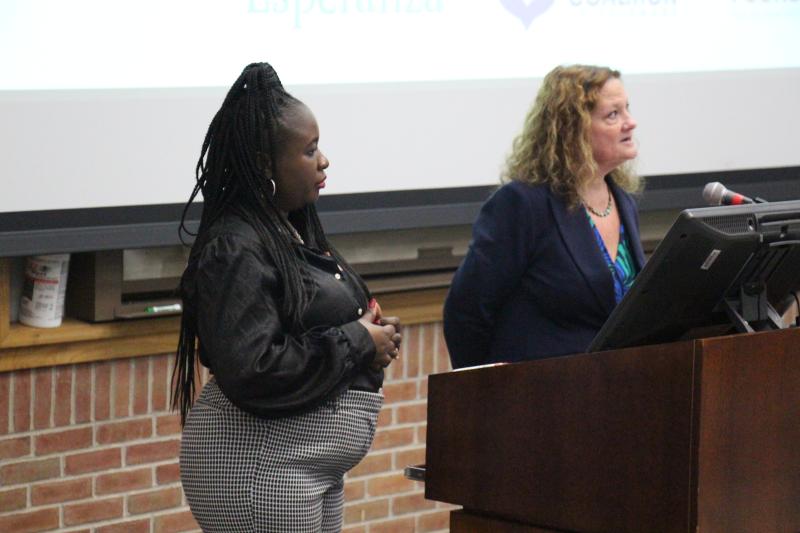Study: Latino, Haitian groups need housing, jobs, childcare
As a study on the growing Latino and Haitian communities in Sussex County was released Feb. 1, organizers of the project said their goal of meeting those residents’ needs will be complicated by a nationwide crackdown on undocumented immigrants.
Many Latinos and Haitians in the county have similar needs involving housing, jobs, education, healthcare, childcare and legal issues, according to the study conducted by La Esperanza and the Haitian Coalition of Delaware, and funded by the Regional Foundation.
The Thriving Newcomers Project focused on Georgetown, where 36% of residents are Hispanic or Latino and 3% are Haitian; Milford, with 16.5% Hispanic or Latino and 6% Haitian populations; Seaford, with 12% Hispanic or Latino and 8% Haitian populations; and Laurel, with 8% Hispanic or Latino and 2% Haitian populations. Organizers said their numbers were typically undercounted in the federal census.
The Spanish-speaking population has increased dramatically in the past 40 years, while Haitians have been arriving in increasing numbers, the study notes, citing census data. The results were released during an event at Delaware Technical Community College Owens Campus in Georgetown.
Conspicuous by their absence at the event were many members of the communities who were the subject of the report.
“It would have brought joy to me if they were here with us,” said a roundtable discussion member who identified herself only as Karina. “As you can see, they are not here. It is a difficult thing because they want to be here, but as you may be aware, there is a lot of fear because of all the challenges that we are facing. But this has not stopped us from being proud.”
Bryant Garcia, co-executive director of La Esperanza, translated from Spanish to English as Karina spoke.
“We are dreaming of something big, and we believe we are valued, and we believe that together we can accomplish many things,” she said. “We came to the conclusion that all of our groups face a lot of the same barriers if we are not from the United States, such as housing, child care, transportation, work.”
Garcia said his group counsels immigrants on their immigration status, on whatever immigration relief they may be eligible for, and he helps them navigate the immigration system. He said even legal immigrants are living in fear because they worry they may also face legal challenges.
Resident leaders were recruited to help design the survey process, said Jennifer Fuqua, co-executive director of La Esperanza. They went to flea markets, grocery stores and other locations frequented by immigrants to gather their comments and needs.
Marleny Kimberly, a resident leader who serves on the study’s advisory committee, said she is the child of immigrants. After interviewing more than 400 people, she said she was touched by the challenges faced by immigrants in the Haitian and Latino communities.
People need language access, in some cases including Spanish or Creole language literacy, before they can move on to English, and communications skills to get into college and get a better job and to get transportation to get to work, Fuqua said of the study results.
“So many people do shift work overnight,” she said. “Access to child care, or utilizing the traditional child care, is just really not an option. People have a network of friends who take care of each other.”
Survey results will be used in the next phase, when residents and other stakeholders meet in March to talk about plans to lobby for action at the local, state and federal levels, Fuqua said.
Beginning in the late 1980s, immigrants were drawn to Sussex County for work in agriculture, particularly the poultry industry, and jobs serving the needs of tourists and retirees.
The Latino community is diverse, varying by country of origin, culture, languages and immigration status, according to the study. Mexico is the most common country of origin, with 15,000 residents from there. There are 5,200 residents from Guatemala in the western part of the county.
About 4,100 Haitians lived in the county in 2020, ranking it fifth among the most common birthplaces of foreign-born residents. Haitian Creole is the primary language in 4,740 households.
Among the 237,378 residents of Sussex County are 26,793 Hispanic residents and 1,693 Haitian residents, according to census data cited in the study. Many of them do not speak English; in some communities, more than 20% live in poverty.
Concerns varied slightly between the groups, with healthcare being the top issue raised by Hispanic residents, while Haitians named education as the main concern.
Midline Oware and Keda Dorisca, co-chairs of the Haitian Coalition of Delaware, said they face challenges in finding solutions due to the federal crackdown on undocumented immigrants.
“Right now, we are seeing a lot of fear and apprehension, and we know that’s kind of expected,” Oware said. “What we’re trying to do is disseminate accurate information and leaning into community. And really helping to reach out to communities to let them know their voices are heard. We need to share accurate information and stop the spread of misinformation to alleviate some of that fear.”
Kevin Conlon came to the Cape Gazette with nearly 40 years of newspaper experience since graduating from St. Bonaventure University in New York with a bachelor's degree in mass communication. He reports on Sussex County government and other assignments as needed.
His career spans working as a reporter and editor at daily newspapers in upstate New York, including The Daily Gazette in Schenectady. He comes to the Cape Gazette from the Cortland Standard, where he was an editor for more than 25 years, and in recent years also contributed as a columnist and opinion page writer. He and his staff won regional and state writing awards.
Conlon was relocating to Lewes when he came across an advertisement for a reporter job at the Cape Gazette, and the decision to pursue it paid off. His new position gives him an opportunity to stay in a career that he loves, covering local news for an independently owned newspaper.
Conlon is the father of seven children and grandfather to two young boys. In his spare time, he trains for and competes in triathlons and other races. Now settling into the Cape Region, he is searching out hilly trails and roads with wide shoulders. He is a fan of St. Bonaventure sports, especially rugby and basketball, as well as following the Mets, Steelers and Celtics.





















































